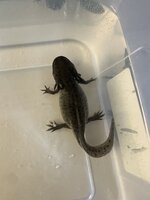marisa
New member
Hi
My axolotl's tank crashed while I was out of town over Christmas. As soon as I got back I had a new filter up and running and began following an in tank cycling guide. My parameters were high in nitrites. When the water wasn't improving i took her out and began tubbing her for the last 2 weeks (switching tubs every 12 hours). We went to an exotic vet and had x-rays done and a physical exam. we tried a 5-day trial of antibiotics in case there was a bacterial infection. She still has not eaten, is not interested in food, and even sometimes begins gagging/gulping when i put any food near her. She has not pooped since before christmas. I have offered her nightcrawlers, salmon, brine shrimp, bloodworms, and pellets. I have tried using garlic guard. Nothing seems to entice her. She still looks relatively healthy. Gills are normal, coloring is normal, and she hasn't lost weight. She is also not getting bigger or bloating. I am stumped. Please let me know what i can do next.



My axolotl's tank crashed while I was out of town over Christmas. As soon as I got back I had a new filter up and running and began following an in tank cycling guide. My parameters were high in nitrites. When the water wasn't improving i took her out and began tubbing her for the last 2 weeks (switching tubs every 12 hours). We went to an exotic vet and had x-rays done and a physical exam. we tried a 5-day trial of antibiotics in case there was a bacterial infection. She still has not eaten, is not interested in food, and even sometimes begins gagging/gulping when i put any food near her. She has not pooped since before christmas. I have offered her nightcrawlers, salmon, brine shrimp, bloodworms, and pellets. I have tried using garlic guard. Nothing seems to entice her. She still looks relatively healthy. Gills are normal, coloring is normal, and she hasn't lost weight. She is also not getting bigger or bloating. I am stumped. Please let me know what i can do next.

